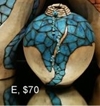Jezebel Gallery » Hosted Artists » Mark & Kathy Doolittle
 Agate Gourd |
 Contemporary Gourd A |
 Contemporary Gourd B |
 Fossil Fish |
 Lotus Flower |
 Waterfall Gourd |
 Jar Gourd A |
 Jar Gourd B |
 Jar Gourd C |
 Jar Gourd D |
 Jar Gourd E |
 Jar Gourd F |
 Standard Gourd A |
 Standard Gourd B |
 Standard Gourd C |
 Standard Gourd D |
 Standard Gourd E |
|
 Urn Gourd A |
 Urn Gourd B |
 Urn Gourd C |
 Urn Gourd D |
 Urn Gourd E |
 Urn Gourd F |
Mark & Kathy Doolittle - Frequently Asked Questions1. Who are the artists responsible for the gourd artwork; are the gourds painted?
Kathy Doolittle is the artist responsible for creating the gourds that are listed as jar, urn, standard design, and contemporary design. Her colorful style is done by applying handmade papers to the gourd surface using an archival glue. A woodburning tool is then used to create the freeform mosaic-like patterns. 2. What is a gourd? Are they stable, or do they eventually rot? Do the artists grow the gourds themselves? Gourds are related to pumpkins and squash and grow on a vine. There are several types of gourds, but the ones that are used for artwork are called hard shell gourds; they are mostly inedible, but when dried, their shells become nearly as hard as wood. Once dried they are as also as stable as wood, and do not rot; indeed, intact gourd vessels have been discovered in the tombs of Egyptian pharaohs. The artists do not grow the gourds; instead, they obtain them from a gourd farm near San Diego. 3. Do the colors fade? Like all artwork, the colors will fade in direct sunlight but will remain very stable under normal, indoor lighting. They should not be kept outdoors. 4. Can you put water or candles in the gourds? No. The gourds are not water sealed, and like wood, they are potentially flammable. Indeed, water will ruin them, so keep the gourd in a dry, indoor location. No other care is required. 5. What is the shiny stuff that I see in the inside bottom of some of the gourds? To clean out the dried seeds that are inside of gourds, the artists often drill a large access hole in the bottom. Once cleaned, a plastic resin is poured inside to seal the hole, and when it dries, its surface becomes shiny. Sometimes the artists also mix in some small river rock with the resin to weight the bottom of the gourd so that it will be stable when standing. 6. Is the carving done by laser or CNC machinery? Are all of the carvings done in the gourd itself, or did the artist add wood or other materials? All of the carvings are done by hand either by applying handmade papers to the gourd surface using an archival glue or by using small rotary bits and burrs and hand tools such as chisels, files and rasps; neither laser nor CNC machinery is ever employed. All of the carvings are done on the gourd surface itself; no additional materials are added. A woodburning tool is then used to create the freeform mosaic-like patterns. The one exception is the “Lotus Flower” gourd. The Lotus flower has 3 layers of petals: the outer two layers of flower petals were carved from basswood, and then added to the first layer of flower petals that were carved from the gourd surface itself. 7. Where do you find gourds with all of the lacy holes? The shell of a gourd is solid like wood, and does not naturally contain any holes at all. All of the holes and texture, no matter how small, were created by the artist. His intent is for his carvings to look like they “grew” that way, although in reality, it is all done by the hand of the artist. 8. Is that a real fossil fish in the “Fossil Fish” gourd? Yes it is. The fossil is from the Green River Formation in Utah. The scientific name of this particular fish is Diplomystus dentatus, and it lived some 50 million years ago in a large inland sea where Utah and Wyoming are now located. The fish was fossilized in sandstone, and it was carefully removed from the sandstone matrix by the artist who then inlayed and adhered it to the gourd surface. 9. What is used to create the colors in some of the carvings? Wood dyes and stains are used; sometimes they are applied with an airbrush, like in the petals of the Lotus flower gourd. | |||||

